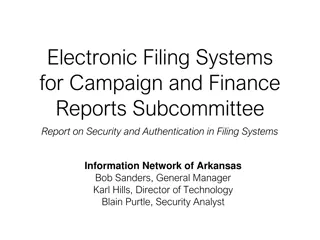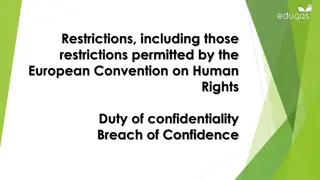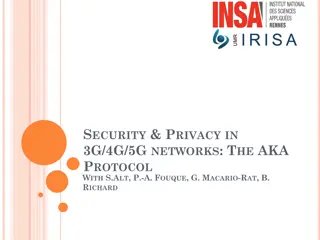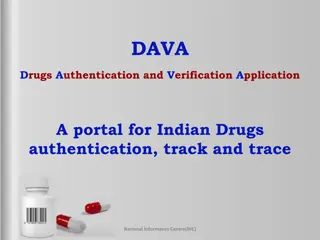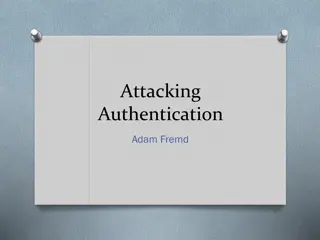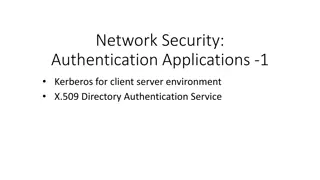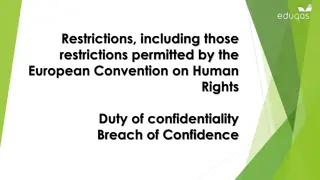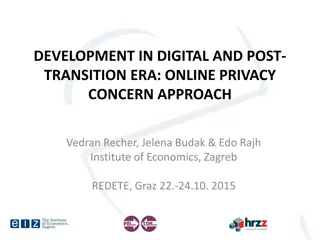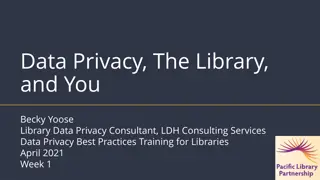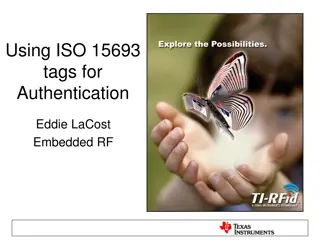Uncovering Flaws in Authentication Solutions: A Privacy Concern
Delve into the potential privacy risks posed by design flaws in authentication solutions, as discussed by security consultant David Johansson. Explore scenarios where digital identities can be compromised, the implications of exposed electronic IDs, and the urgent need for software updates to safeguard personal information. Understand the gravity of the privacy problem in authentication processes and the necessity for stringent security measures.
Download Presentation

Please find below an Image/Link to download the presentation.
The content on the website is provided AS IS for your information and personal use only. It may not be sold, licensed, or shared on other websites without obtaining consent from the author. Download presentation by click this link. If you encounter any issues during the download, it is possible that the publisher has removed the file from their server.
E N D
Presentation Transcript
Identities Exposed How Design Flaws in Authentication Solutions May Compromise Your Privacy
About Me David Johansson Started working as a security consultant in 2007 Building security solutions (e.g., SAML 2.0 IdP) Helping others design and build secure software Based in London since 3 years, working for Cigital (now part of Synopsys)
Your Privacy WHAT IF EVERYONE KNOWS WHO YOU ARE?
Your Privacy Would you walk around everywhere showing your passport openly? In the digital world, it could well happen without you ever knowing
Digital Identities Name Issuer Validity Also contains: Serial number Information binding it to the subject Forgery protection, etc.
National Electronic ID In Sweden we have national electronic IDs Used for online authentication/signing Government e-services, Online banks, etc. Contains PII Full name, Date of birth, Personal identity number (NIN/SSN-equivalent) Based on client certificates protected by custom software
Please Update Your Software! In 2013, a letter was sent out to around 500,000 individuals in Sweden Urged users to update their electronic ID software Why such a drastic action? Imagine Microsoft s Patch Tuesdays being delivered by Royal Mail
1 Million Identities Exposed Possible to enumerate certificates by calling plugin through JavaScript No user interaction needed, no need of previous authentication Any site could silently identify you even if you were using proxies, TOR network, etc. document.iID.EnumProperty('Certificate','0')
The Privacy Problem Was this just an odd software error? Or is there a problem with privacy in authentication solutions in general?
Authentication Solutions PRIVACY REQUIREMENTS
Security vs. Privacy Security is considered an important aspect when designing authentication: Password policies Multi-factor authentication Protect passwords in transit and at rest Prevent brute-force attacks Prevent replay attacks, etc. But does this protect users privacy?
[Privacy] User Stories As a user, I want to knowwho I communicate with before I authenticate myself so that I avoid revealing my identity to unknown entities.
[Privacy] User Stories As a user, I want to knowwhen I authenticate so that I only reveal my identity when I intend to do so.
[Privacy] User Stories As a user, I want to knowand controlwhat information I reveal when I authenticate so that I only reveal information about myself that I intend to share with the other party.
[Privacy] User Stories As a user, I want to know thatonly the intended recipient can see my identity when I authenticate so that I don t expose my identity to others listening in on the conversation.
Privacy Requirements [PRIVACY] USER STORY PRIVACY REQUIREMENT Know who I communicate with System authenticates before user Know when I authenticate Explicit or implicit approval of authentication Know and control what information I reveal Explicit or implicit approval of which identity data to share Know that only the intended recipient can see my identity Secure transmission of identity data
Privacy Issues in SSL/TLS CLIENT CERTIFICATE AUTHENTICATION
SSL/TLS Mutual Authentication Client and server wants to establish a secure connection Server may ask for client certificate during SSL/TLS handshake Are the privacy requirements for clients fulfilled in SSL/TLS?
TLS Client Privacy - Round 1: Internet Explorer vs. Chrome DEMO 1: THE BROWSER BUG
Chromes Privacy Error Client Spoofed Server Client Hello Server Hello Server Certificate Server Key Exchange* Certificate Request Server Hello Done Forged (invalid) server certificate No warning in browser Client Certificate Client Key Exchange Certificate Verify ChangeCipherSpec Browser validates certificate and displays warning after handshake completes Client sends certificate to spoofed server The user is warned of the certificate error, but the identity of the client is already exposed. Finished *Server Key Exchange is only sent when more than the server certificate is needed for the key exchange, e.g. ephemeral Diffie-Hellman.
And the winner is Privacy - Round 1: Microsoft IE 1 0 Google Chrome Wait, not so fast! Internet Explorer used to do the same and in fact all browsers can be fooled!
SSL/TLS Privacy Flaw Client My The real Spoofed Server www.example.com Client Hello Use the real site s public certificate Spoofed server identifies itself as the legitimate server Server Hello Server Certificate Certificate Request Server Hello Done Pick cipher with static RSA key exchange*, e.g., TLS_RSA_WITH_AES_256_CBC_SHA Client Certificate Client Key Exchange Certificate Verify ChangeCipherSpec Client authenticates to spoofed server The SSL/TLS connection then fails, but the identity of the client is already exposed. Finished *Server Key Exchange message is not required for static RSA key exchange - > no explicit validation of server s private key possession.
TLS Client Privacy - Round 2: All Your Identities Are Belong To Us DEMO 2: THE TLS PRIVACY FLAW
Active Attacks This protocol flaw can be exploited in active attacks to expose identities through client certificates For example, inject hidden iFrame with HTTPS URL in any plain HTTP response Intercept TLS handshake for HTTPS request and request client certificate Browser prompts user or may even send client certificate without user s knowledge
Passive Eavesdropping Client Server Client Hello Server Hello Server Certificate Server Key Exchange* Certificate Request Server Hello Done Client Certificate Client Key Exchange Certificate Verify ChangeCipherSpec Eavesdropping on network communication Plaintext Ciphertext Finished *Server Key Exchange is only sent when more than the server certificate is needed for the key exchange, e.g. ephemeral Diffie-Hellman.
SSL/TLS Mutual Authentication PRIVACY REQUIREMENTS System authenticates before user Explicit or implicit approval of authentication Explicit or implicit approval of which identity data to share Secure transmission of identity data Privacy requirements are not fulfilled in SSL/TLS Mutual Authentication.
TLS 1.3 Privacy Improvements The draft of TLS 1.3 contains several improvements to privacy Explicit verification of server s key possession CertificateVerify: signature over entire handshake Encrypts communication before sending client certificate However, TLS 1.3 is still work in progress and will likely take time before widely supported For now, avoid storing PII in client certificates used with TLS
Passive authentication requests in SAML 2.0 SSO
SSO within an Organization App App App IdP App App We typically have some level of trust for all applications within our organization
SSO across Organizations Trust IdP App App Trust Trust? App App App App App
Passive AuthnRequest Privacy requirement not met A Boolean value. If "true", the identity provider and the user agent itself MUST NOT visibly take control of the user interface from the requester and interact with the presenter in a noticeable fashion. If a value is not provided, the default is "false".
Conclusions Users privacy often neglected Secure authentication doesn t necessarily mean that privacy is protected Several solutions have privacy flaws Protect your users privacy Privacy requirements must be considered when designing authentication solutions
Questions? (Whitepaper on TLS privacy issues to be released soon )









